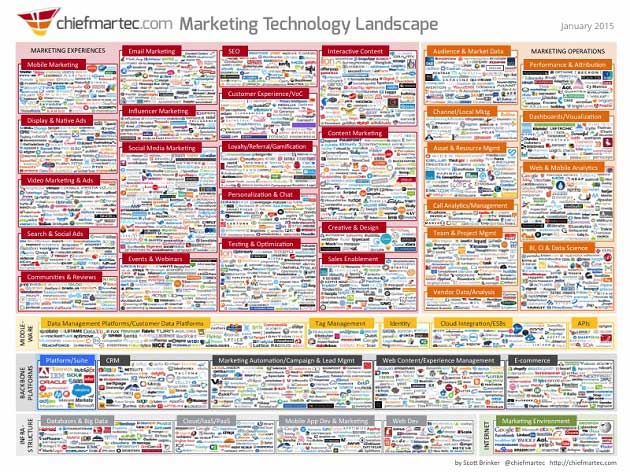Ever feel like there's an overwhelming amount of marketing technology these days? It's not just you.
I recently released an updated version of my marketing technology landscape graphic, and it maps out a whopping 1,876 companies (and open source projects) offering software to marketing departments. That's nearly double the number from last year's edition, which charted 947.
Astoundingly, this infographic still isn't comprehensive—although it's close.
We could debate which companies were included or omitted, in which categories, and what the labels of those categories are. Deciding all that is challenging because the industry and its nomenclature are constantly evolving and many products cross multiple categories.
But the main point of this graphic is to illustrate that the marketing technology environment is massive.
Point made, right?
All these companies are serving a large and growing market. The worldwide spend for marketing software in 2015 will be $22.6 billion and will grow to $32.3 billion by 2018, IDC estimates.
Consolidation will certainly occur, as major enterprise software providers, such as Adobe, IBM, Oracle, and Salesforce, continue to acquire firms and seek to dominate key categories in the field.
At the same time, I expect the landscape will continue to be highly diverse for some years to come—particularly in the top of half of this landscape graphic. New, innovative startups are still emerging to keep pace with the ever-changing expectations for customer experience. For example, just as a thriving category of content marketing tools has blossomed, a new category of interactive content marketing software is popping up behind it.
As long as the environment in which marketers have to engage customers continues to advance—for instance, consider all the cool possibilities for hybrid digital/physical experiences that the Internet of Things will enable—new opportunities will exist for marketing technology entrepreneurs.
For marketers, those changes are a blessing and a curse. It is a bounty of possibilities for differentiating your marketing capabilities, and competition among these different vendors will serve to drive down prices and drive up innovation. But, at the same time, it is a dauntingly large and complex landscape to navigate.
However, there is good news regarding being able to manage this complexity. Many of the major marketing cloud providers have invested heavily in building official ISV ecosystems—making it easier for you to plug in specialized capabilities from many of these other vendors without rubber bands and chewing gum. A growing cluster of "marketing middleware" is also making it more feasible to "build your own" marketing cloud.
The human resources necessary to harness all this marketing technology are also starting to catch up. Collaboration between Marketing and IT is improving across the board, and the continued rise of hybrid marketing technologist professionals is imbuing marketing departments with more native technical prowess.
Marketing technology management is going to be an ongoing journey, and a challenging one. But like the vibrant nature of modern marketing overall, it definitely won't be dull.





